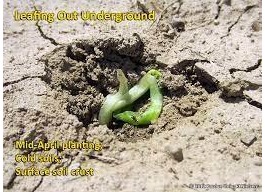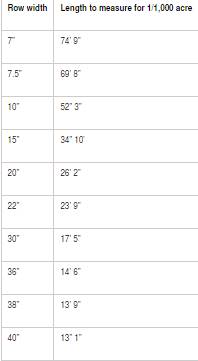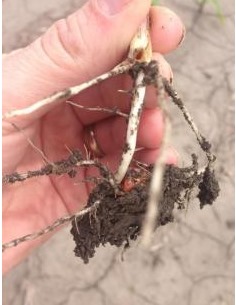By Clarabell Probasco and Virgil Schmitt
Many farmers across the state of Iowa found a nice, early window to get the 2023 planting season kicked off. The second week of April became busy with tillage, planting (both corn and soybeans), and herbicide passes. Unfortunately, that window closed quickly and left us with extended cool temperatures and, for some, needed moisture.
The cooler temperatures that followed the fields planted in the April 7th – 14th timeframe may have negatively impacted the emergence and growth of the crops. Fields that received rainfall events may also be dealing with crusting issues. Soil crusts mixed with slower germination and growth may result in less uniform crop stands. Corn plants may begin to leaf out underground and soybeans may begin to pale in color. These would be considered abnormal plant characteristics.

Now that temperatures have begun to steadily warm up, many of these farmers have returned to the fields to continue in their 2023 planting season endeavors. The USDA Crop Progress and Condition report shows that as of May 8th, 70% of the state’s corn acres have been planted while 49% of the soybean acres are planted. Farmers are also returning to the fields that have already been planted or received herbicide applications to see how things are shaping up. When deciding if plants look normal or abnormal, factor in the plant color, size, and vigor.
As we begin checking those early fields, there are a handful of key items we want to work our way through:
- Stand counts and uniformity: How well is my crop emerging?
- Growth stages: Where is my crop at developmentally?
- Herbicide considerations: Are there any issues?
- Insects: Is there pressure to consider?
- Are seed rots and / or seedling diseases injuring my corn and/or soybeans?
- Replant decisions: How do I decide?
Stand counts: How well is my crop emerging?
The chilly temperatures the last few weeks of April delayed emergence in many fields across the state. This means that the corn or soybean seed sat in the ground longer than is ideal, and it is important to get out and see how well seed tolerated the lower temperatures. If stands are not emerging uniformly or we see seed/seedling damage, we may have to consider what our options are for letting the seed continue to emerge, hopefully quickly over the next few days, or if the considerations of replant need to begin being worked through.
Traditional stand count methods for both corn and soybeans consist of measuring out 1/1000th of an acre in one row, based on the row width for that crop and field.

The emerged and viable plants in that 1/1000th of an acre are multiplied by 1,000 to get the plant per acre population. Multiple stand count assessments should take place across the field to gain a more accurate population count for the entire field. Areas should be randomly selected to achieve the most accurate results. If a portion of the field looks worse than the rest of the field and the area is large enough to manage differently from the rest of the field, conduct stand assessments there independent of the rest of the field.
More detailed instructions on how to complete a stand assessment for soybeans, including alternative methods for estimating a soybean stand count, can be found here , and for corn, can be found here.
Growth stages: Where is my crop at developmentally?
Properly identifying the growth stage of the crops in the field plays an important role in allowing us to work through our upcoming management decisions. Post applications for herbicides are highly dependent on knowing the growth stage of the field to determine which products can or cannot be applied for weed control. Decisions of side-dressing fertilizers may also be impacted by the growth stage of the crop. The Corn Growth Stages and Soybean Growth Stages articles are great refreshers on what to look for when identifying those stages.
Herbicide considerations: Are there any issues?
Burn downs with herbicides may or may not have been affected by the cool down. Glyphosate products tend to lose performance when nighttime temperatures fall below 40 degrees and daytime temperatures do not reach 60 degrees. Using low rates of glyphosate and/or applying UAN with glyphosate can make matters worse. Dicamba and 2,4-D products used as a burn down do not seem to be negatively impacted by cool temperatures as long as the plant tissue has not been damages by the weather. Weeds that have escaped burn down treatments should be managed promptly. For more considerations on herbicide decisions with preemergence soybean products, read through this recent blog: Look before you leap: Cautions for delayed preemergence applications in soybean.
Insects: Is there pressure to consider?
As you work through scouting the early planted fields, keep an eye out for insect pests. If seed or seedling damage doesn’t seem to line up with the symptomology of cooler weather or herbicide damage, it could be linked to insect issues. While standard insecticide seed treatments generally manage pests like white grubs, wireworms, and seedcorn maggots well, it is still best to be on the lookout for them. White grubs will feed on the root tissues of corn or soybeans but are unlikely to cause any economic injury. Most commonly they will be in fields that were previously sod, cover crops, or had Japanese beetles the previous year. Wireworms typically feed when corn is planted early and is followed by cooler weather. Feeding takes place on the germ or corn kernels, leaving the seed to be hollowed out. It can also occur on the roots and portion of the stem that remains underground. Most commonly, they will be a problem following a sod crop.

Seedcorn maggots can affect corn or soybean seeds by burrowing into the seed and eating the embryo. This prevents the seed from germinating and can create gaps in the crop’s stand. Seedcorn maggots are most commonly found in heavily manured fields or that have had a green manure crop tilled in.
In severe cases, these pests may cause enough stand damage to warrant replanting. With the cooler temperatures this spring, be sure to include looking for these pests in your field scouting routine. As the growing season continues and we begin scouting for additional pests, be sure to utilize the Pest Forecasting Maps to stay informed on potential pest emergence for your area of the state. This resource can be found on the Iowa Environmental Mesonet.
Are seed rots and / or seedling diseases injuring my corn and/or soybeans?
With the exception of organic production, all seed corn is treated with a fungicide seed treatment and many farmers also treat their early-planted soybean seed with fungicides. While these products do their job very well, they do have limits, and an extended time of the seed / seedling being in cool and moist soils can “overwhelm” the fungicides’ efficacy. Pythium, Fusarium and Rhizoctonia can infect both corn and soybeans and Phytopthora can also be a problem in soybeans. Inspect several plants throughout the field for signs of decay of the seed, seedling below-ground structures, and soybean stems.
A more in-depth discussion of identifying seed rot and seedling diseases in both corn and soybean can be found in this article from 2019.
Replant decisions: How do I decide?
A careful assessment of stand numbers, stand uniformity, and stand health needs to be considered before deciding that a corn or soybean field needs to be replanted. The current potential for yield should be calculated against what the potential yield of a field of replant will be. If stands are looking unsatisfactory, work through this Soybean Replant Checklist and Corn Replant Checklist to determine if replanting the field is a necessary or viable option.
Reach out to your local field agronomist if any assistance is needed with field issues that are discovered while scouting.
Source : iastate.edu